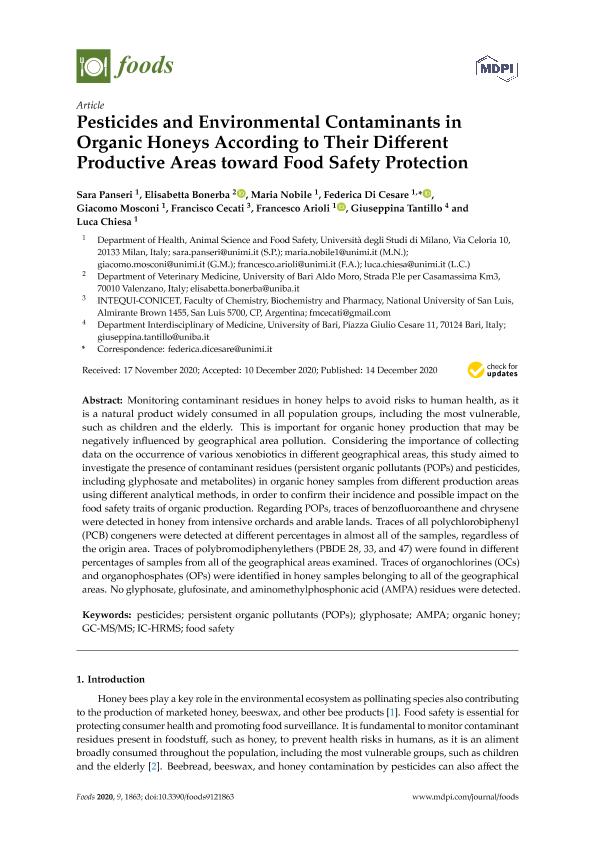Artículo
Pesticides and environmental contaminants in organic honeys according to their different productive areas toward food safety protection
Panseri, Sara; Bonerba, Elisabetta; Nobile, Maria; Di Cesare, Federica; Mosconi, Giacomo; Cecati, Francisco Miguel ; Arioli, Francesco; Tantillo, Giuseppina; Chiesa, Luca
; Arioli, Francesco; Tantillo, Giuseppina; Chiesa, Luca
 ; Arioli, Francesco; Tantillo, Giuseppina; Chiesa, Luca
; Arioli, Francesco; Tantillo, Giuseppina; Chiesa, Luca
Fecha de publicación:
11/2020
Editorial:
MDPI AG
Revista:
Foods
ISSN:
2304-8158
Idioma:
Inglés
Tipo de recurso:
Artículo publicado
Clasificación temática:
Resumen
Monitoring contaminant residues in honey helps to avoid risks to human health, as it is a natural product widely consumed in all population groups, including the most vulnerable, such as children and the elderly. This is important for organic honey production that may be negatively influenced by geographical area pollution. Considering the importance of collecting data on the occurrence of various xenobiotics in different geographical areas, this study aimed to investigate the presence of contaminant residues (persistent organic pollutants (POPs) and pesticides, including glyphosate and metabolites) in organic honey samples from different production areas using different analytical methods, in order to confirm their incidence and possible impact on the food safety traits of organic production. Regarding POPs, traces of benzofluoroanthene and chrysene were detected in honey from intensive orchards and arable lands. Traces of all polychlorobiphenyl (PCB) congeners were detected at different percentages in almost all of the samples, regardless of the origin area. Traces of polybromodiphenylethers (PBDE 28, 33, and 47) were found in different percentages of samples from all of the geographical areas examined. Traces of organochlorines (OCs) and organophosphates (OPs) were identified in honey samples belonging to all of the geographical areas. No glyphosate, glufosinate, and aminomethylphosphonic acid (AMPA) residues were detected.
Archivos asociados
Licencia
Identificadores
Colecciones
Articulos(INTEQUI)
Articulos de INST. DE INVEST. EN TECNOLOGIA QUIMICA
Articulos de INST. DE INVEST. EN TECNOLOGIA QUIMICA
Citación
Panseri, Sara; Bonerba, Elisabetta; Nobile, Maria; Di Cesare, Federica; Mosconi, Giacomo; et al.; Pesticides and environmental contaminants in organic honeys according to their different productive areas toward food safety protection; MDPI AG; Foods; 9; 12; 11-2020; 1-15
Compartir
Altmétricas



